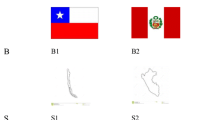Abstract
The current study was a replication of Petursdottir and Aguilar (Journal of Applied Behavior Analysis, 46, 58–68, 2016). Two different stimulus presentations were evaluated during auditory-visual discrimination training. A sample-first procedure, in which the sample stimulus was presented before the comparison stimuli, was compared to a comparison-first procedure, in which the sample presentation was presented after the comparison stimuli. The results indicated that both participants learned more quickly in the comparison-first condition, a finding that differed from Petursdottir and Aguilar (Journal of Applied Behavior Analysis, 46, 58–68, 2016).


Similar content being viewed by others
References
Coon, J. T., & Miguel, C. F. (2012). The role of increased exposure to transfer-of-stimulus control procedures on the acquisition of intraverbal behavior. Journal of Applied Behavior Analysis, 45, 657–666. https://doi.org/10.1901/jaba.2012.45-657.
Doughty, A. H., & Saunders, K. J. (2009). Decreasing errors in reading-related matching to sample using a delayed-sample procedure. Journal of Applied Behavior Analysis, 42, 717–721. https://doi.org/10.1901/jaba.2009.42-717.
Green, G. (2001). Behavior analytic instruction for learners with autism: Advances in stimulus control technology. Focus on Autism and Other Developmental Disabilities, 16, 72–85.
Leaf, R., & McEachin, J. (Eds.). (1999). A work in progress: Behavior management strategies and a curriculum for intensive behavioral treatment of autism. New York, NY: DRL Books.
Lovaas, O. I. (2003). Teaching individuals with developmental delays: Basic intervention techniques. Austin, TX: Pro-Ed.
Martin, N., & Brownell, R. (2011). Receptive one-word picture vocabulary test (4th ed.). Novato, CA: Academy Therapy Publications.
McIlvane, W. J., Kledaras, J. B., Stoddard, L. T., & Dube, W. V. (1990). Delayed sample presentation in MTS: Some possible advantages for teaching individuals with developmental limitations. Human Behavior Bulletin, 8, 31–33.
Miguel, C. F., Frampton, S. E., Lantaya, C. A., LaFrance, D. L., Quah, K., Meyer, C. S., et al. (2015). The effects of tact training on the development of analogical reasoning. Journal of the Experimental Analysis of Behavior, 104, 96–118. https://doi.org/10.1002/jeab.167.
Petursdottir, A. I., & Aguilar, G. (2016). Order of stimulus presentation influences children’s acquisition in receptive identification tasks. Journal of Applied Behavior Analysis, 46, 58–68. https://doi.org/10.1002/jaba.264.
Schneider, K. A., Devine, B., Aguilar, G., & Petursdottir, A. I. (2018). Stimulus presentation order in receptive identification tasks: A systematic replication. Journal of Applied Behavior Analysis, 51, 634–646. https://doi.org/10.1002/jaba.459.
Sindelar, P. T., Rosenberg, M. S., & Wilson, R. J. (1985). An adapted alternating treatments design for instructional research. Education and Treatment of Children, 8, 67–76.
Vedora, J., Barry, T., & Ward-Horner, J. C. (2017). An evaluation of differential observing responses during receptive label training. Behavior Analysis in Practice, 10, 290–295. https://doi.org/10.1007/s40617-017-0188-6.
Author information
Authors and Affiliations
Corresponding author
Ethics declarations
Conflict of Interest
Joseph Vedora declares that he has no conflict of interest. Tiffany Barry declares that she has no conflict of interest. John C. Ward-Horner declares that he has no conflict of interest.
Ethical Approval
All procedures performed in studies involving human participants were in accordance with the ethical standards of the institutional and/or national research committee and with the 1964 Helsinki declaration and its later amendments or comparable ethical standards.
Informed Consent
Informed consent was obtained from all individual participants included in the study.
Rights and permissions
About this article
Cite this article
Vedora, J., Barry, T. & Ward-Horner, J.C. Sample First versus Comparison First Stimulus Presentations: Preliminary Findings for Two Individuals with Autism. Behav Analysis Practice 12, 423–429 (2019). https://doi.org/10.1007/s40617-018-00299-1
Published:
Issue Date:
DOI: https://doi.org/10.1007/s40617-018-00299-1




